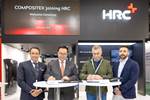HRC, Airbus LSC launch aircraft dismantling, recycling project
The first project is underway to recover carbon fiber used in an A330-200 aircraft, which will then be regenerated for other end uses by HRC.
Source | Airbus, HRC
On Aug. 29 in Chengdu, China, the Airbus Lifecycle Services Center (ALSC) and HRC (Shanghai, China) established a strategic partnership to launch China’s first aircraft dismantling and recycling project. This initiative, signed by Brian Agnew, general manager of ALSC, and Zhiyong Wang, general manager of carbon neutrality at HRC, represents a step forward in promoting sustainable aviation practices in the region.
The collaboration combines HRC’s expertise in the full life cycle of carbon fiber with ALSC’s position as an aircraft recycling project operated by an aircraft manufacturer. Together, the partners aim to achieve high material recovery rates, reduce operational costs and minimize environmental impact.
HRC is responsible for recycling and reusing aircraft carbon fiber composites to extend their life cycle and maximize resource reutilization. By turning the wastes into regenerated intermediate carbon fiber and end-production products with low emissions, high physical performance and added value, HRC bolsters the circular economy in aviation.
The first project under this partnership involves the dismantling of an A330-200 aircraft.
Related Content
-
The potential for thermoplastic composite nacelles
Collins Aerospace draws on global team, decades of experience to demonstrate large, curved AFP and welded structures for the next generation of aircraft.
-
Plant tour: Airbus, Illescas, Spain
Airbus’ Illescas facility, featuring highly automated composites processes for the A350 lower wing cover and one-piece Section 19 fuselage barrels, works toward production ramp-ups and next-generation aircraft.
-
Revisiting the OceanGate Titan disaster
A year has passed since the tragic loss of the Titan submersible that claimed the lives of five people. What lessons have been learned from the disaster?



